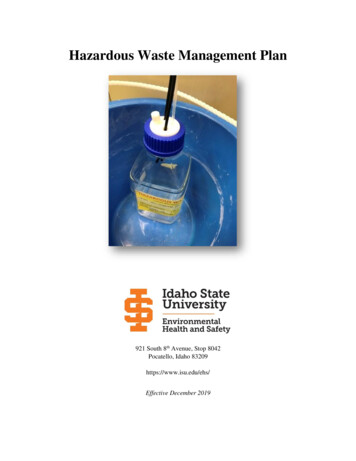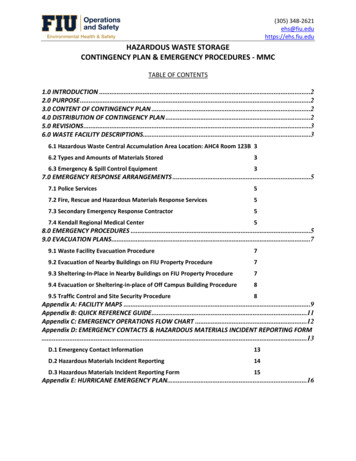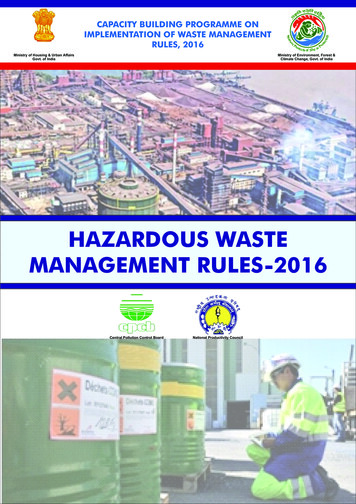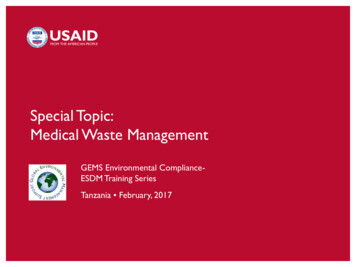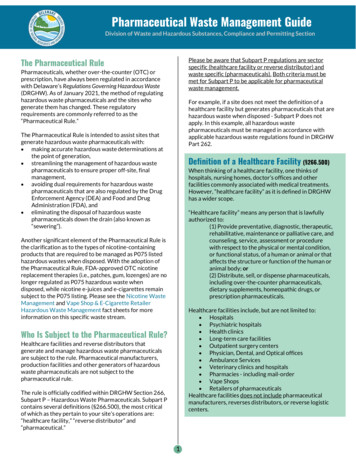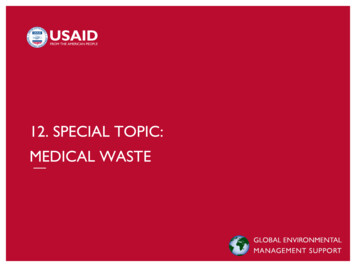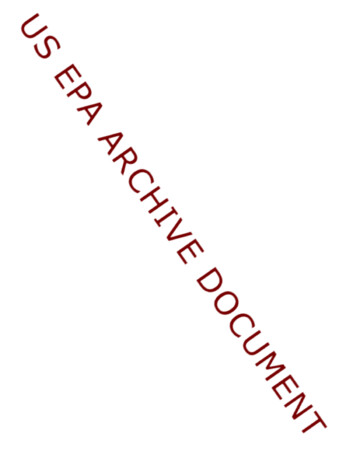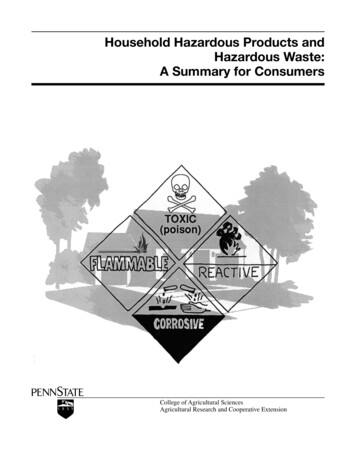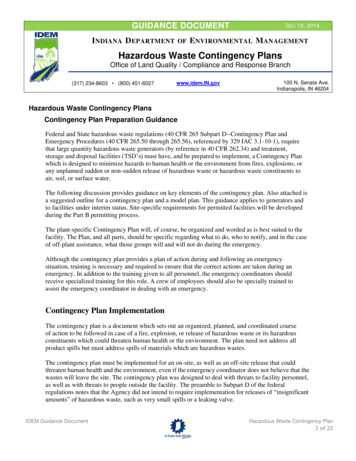
Transcription
GUIDANCE DOCUMENTI NDIANA D EPARTMENTOFDEC 12, 2014E NVIRONMENTAL M ANAGEMENTHazardous Waste Contingency PlansOffice of Land Quality / Compliance and Response Branch(317) 234-8603 (800) 451-6027www.idem.IN.gov100 N. Senate Ave.Indianapolis, IN 46204Hazardous Waste Contingency PlansContingency Plan Preparation GuidanceFederal and State hazardous waste regulations (40 CFR 265 Subpart D--Contingency Plan andEmergency Procedures (40 CFR 265.50 through 265.56), referenced by 329 IAC 3.1-10-1), requirethat large quantity hazardous waste generators (by reference in 40 CFR 262.34) and treatment,storage and disposal facilities (TSD’s) must have, and be prepared to implement, a Contingency Planwhich is designed to minimize hazards to human health or the environment from fires, explosions, orany unplanned sudden or non-sudden release of hazardous waste or hazardous waste constituents toair, soil, or surface water.The following discussion provides guidance on key elements of the contingency plan. Also attached isa suggested outline for a contingency plan and a model plan. This guidance applies to generators andto facilities under interim status. Site-specific requirements for permitted facilities will be developedduring the Part B permitting process.The plant-specific Contingency Plan will, of course, be organized and worded as is best suited to thefacility. The Plan, and all parts, should be specific regarding what to do, who to notify, and in the caseof off-plant assistance, what those groups will and will not do during the emergency.Although the contingency plan provides a plan of action during and following an emergencysituation, training is necessary and required to ensure that the correct actions are taken during anemergency. In addition to the training given to all personnel, the emergency coordinators shouldreceive specialized training for this role. A crew of employees should also be specially trained toassist the emergency coordinator in dealing with an emergency.Contingency Plan ImplementationThe contingency plan is a document which sets out an organized, planned, and coordinated courseof action to be followed in case of a fire, explosion, or release of hazardous waste or its hazardousconstituents which could threaten human health or the environment. The plan need not address allproduct spills but must address spills of materials which are hazardous wastes.The contingency plan must be implemented for an on-site, as well as an off-site release that couldthreaten human health and the environment, even if the emergency coordinator does not believe that thewastes will leave the site. The contingency plan was designed to deal with threats to facility personnel,as well as with threats to people outside the facility. The preamble to Subpart D of the federalregulations notes that the Agency did not intend to require implementation for releases of “insignificantamounts” of hazardous waste, such as very small spills or a leaking valve.IDEM Guidance DocumentHazardous Waste Contingency Plan1 of 22
At a minimum, the plan must map out general strategies to deal with both sudden and non-suddenevents. Such strategies must involve outlining a series of steps to be taken in response to an incidentand should include decision points where outside assistance may be required and the circumstancesunder which evacuation of the facility is advisable. The following criteria should be used in thecontingency plan implementation decision process:1. The contingency plan must be implemented if an imminent or actual incident could threatenthe environment or human health.a. SpillsThe spill could result in release of flammable liquids or vapors creating a fire or gas explosionhazard.The spill could cause the release of toxic liquids, vapors or fumes.The spill can be contained on-site but the potential exists for groundwater pollution due toaquifer contamination.The spill cannot be contained on-site resulting in off-site soil contamination and/or ground orsurface water pollution.b. FiresThe fire could cause the release of toxic vapors or fumes.If the fire spreads, it could ignite materials at other locations at the site or cause heat-inducedexplosions.The fire could spread to off-site areas.Use of water or water and chemical fire suppressant could result in contaminated run-off.c. ExplosionsAn imminent danger exists that an explosion could occur, resulting in a safety hazard due toflying fragments or shock waves.An imminent danger exists that an explosion could ignite other hazardous waste at the facility.An imminent danger exists that an explosion could result in release of toxic material.An explosion has occurred.Emergency CoordinatorsThe facility must select at least one (1) employee who is either on the facility premises during normaloperational periods or is available to respond to an emergency by reaching the facility within a shortperiod of time. This employee must be designated the primary emergency coordinator. The emergencyIDEM Guidance DocumentHazardous Waste Contingency Plan2 of 22
coordinator is responsible for coordinating all emergency response measures, and being thoroughlyfamiliar with:-- The facility’s contingency plan;-- All operations and activities at the facility;-- The location and characteristics of waste handled;-- The location of all records within the facility; and-- The physical layout of the facility.The selected emergency coordinator must have the authority to expend funds and recruit employeesto implement the Contingency Plan. The owner/operator should also select alternate emergencycoordinators if for some reason the designated emergency coordinator may be unavailable.Emergency Response Procedures for Spills, Fires, and ExplosionsThe appropriate level of response to a particular incident is largely a matter of professional judgment.However, the full range of response methods to be employed in a variety of potential situations can beanticipated and, thus, should be outlined as emergency procedures. The level of detail appropriate forthese response procedures is dependent upon a number of factors including:-- The type of waste handled.-- The potential for fires, explosions, or releases.-- The immediate health and safety effect of the incident upon personnel.-- The potential hazard to the outside environment.The contingency plan must contain elements which address emergency procedures to be undertaken:-- Immediately upon discovery of an emergency.-- During emergency control phase.-- Immediately following attainment of control.Immediately upon discovery of an imminent or actual emergency, the first duty of theemergency coordinator is to warn the operating personnel, since they are likely to be the firstgroup exposed to danger. Secondly, appropriate State or local emergency response agenciesshould be called if their assistance is needed to cope with the emergency.In the event of a release, fire, or explosion, the emergency coordinator must identify the character, exactsource, amount, and extent of any released material. He also must assess possible hazards to theenvironment and human health. The identification of the discharged material may be accomplishedthrough observation, review of manifests, and if necessary, by chemical analysis, although responseIDEM Guidance DocumentHazardous Waste Contingency Plan3 of 22
should not be delayed until the analysis is complete.If the release, fire, or explosion could threaten the environment or human health outside the facility, theemergency coordinator must immediately notify the appropriate local authorities and notify either theon-site scene U.S. Environmental Protection Agency (EPA) coordinator for that geographical area, orthe National Response Center at AC 800/424-8802, and the Indiana Department of EnvironmentalManagement (IDEM), Office of Emergency Response at AC 317/233-SPIL (7745).During the emergency control phase, the emergency coordinator must take all reasonable stepsnecessary to ensure that explosions and releases do not occur, recur, or spread to other hazardouswastes at the facility. These steps include, where applicable, stopping operations. The emergencycoordinator must monitor for leaks, pressure buildup, gas generation, or ruptures in valves, pipes, orother equipment, wherever appropriate. Details should be provided to emergency personnel concerningthe types of on-site emergency equipment to be used and the need for personnel protection equipment.Immediately after an emergency, the emergency coordinator must provide for treating, storing, ordisposing of recovered waste, contaminated soil or surface water, or any other material. The recoveredmaterial must be handled as a hazardous waste unless it is a characteristic hazardous waste only, whichis analyzed and determined not to be hazardous. The emergency coordinator must ensure that in theaffected areas of the facility, no waste that may be incompatible with the released material is treated,stored, or disposed until cleanup procedures are completed. All emergency equipment must be cleanedand made fit for its intended use before operations are resumed.Emergency Equipment40 CFR 265.52(e), referenced by 329 IAC 3.1-10-1 of the State hazardous waste regulations, specifiesthat the plan include a list of all emergency equipment at the facility. In addition, the location of thisequipment is to be noted and a physical description of each item on the list is to be provided along witha brief outline of the equipment’s capabilities. Emergency equipment will vary from facility to facility,but must include the following as required by the regulation, unless none of the hazards posed by wastehandled at the facility could require the equipment’s use:-- An internal communication or alarm system capable of providing emergency instructions.-- A device capable of summoning external assistance (telephone or two-way radio).-- Portable fire extinguishers, fire control equipment, spill control equipment,and decontamination equipment.This list will be used by facility personnel during an emergency. The format for the list should,therefore, allow identification of any needed equipment and its location in the easiest possible manner.It is suggested that a plot plan showing the locations of the equipment also be included in the Plan.Evacuation PlanThe Contingency Plan must include an evacuation plan for facility personnel where there is a possibilitythat evacuation could be necessary. Where no possibility exists that facility evacuation could ever beIDEM Guidance DocumentHazardous Waste Contingency Plan4 of 22
necessary, this plan element may be omitted. Situations which would warrant partial or completeevacuation are as follows:-- Explosions resulting in airborne debris including container fragments and hazardous waste.-- Spills or chemical reactions resulting in toxic vapors or fumes.-- Fire when it cannot be contained and is spreading to other parts of the facility, or when firecould generate toxic vapors or fumes.-- All incidents where necessary protective equipment is not available to emergency responsepersonnel.The evacuation plan must ensure the safe egress of facility personnel. The evacuation plan mustindicate a recognizable signal to start evacuation, evacuation routes, and alternate evacuation routes (incase primary exit routes are blocked by releases of hazardous waste or fires).Required ReportsWithin fifteen (15) days after an incident requiring implementation of the contingency plan, the owner oroperator must submit a written report on the incident to the EPA Regional Administrator, and theCommissioner of the Indiana Department of Environmental Management, which includes:-- Name, address, and telephone number of owner/operator.-- Name, address, and telephone number of the facility.-- Date, time, and type of incident.-- Name and quantity of materials involved.-- An assessment of actual or potential hazards to human health or the environment.-- Estimated quantity and disposition of recovered material that resulted from the incident.Before operations are resumed in the affected areas of the facility, the owner/operator must notify theRegional Administrator and appropriate State and local authorities that the facility is in compliance withfollow-up procedures to an emergency, prior to resuming operations in the affected areas.Amendment of the Contingency PlanThe contingency plan must be reviewed, and immediately amended, whenever the following situationsapply: applicable regulations are revised; the plan fails in an emergency; the facility changes in itsdesign, construction, operation, maintenance, or other circumstances in a way that materially increasesthe potential for fires, explosions, or releases; the list of emergency coordinators changes; or the list ofemergency equipment changes.IDEM Guidance DocumentHazardous Waste Contingency Plan5 of 22
For More InformationContact the Compliance Branch, Office of Land Quality at 317-232-8603, or the IDEM toll-freenumber 1-800-451-6027.SuggestedOutlineContingencyPlan1. Facility Identification and General Informationa. Name of Facilityb. Address of Facilityc. Name, Title, Home Address, and Telephone Number (office and home) of PrimaryEmergency Coordinatord. Type of Facilitye. Site Planf. Description of Generator, TSDF Activities2. Emergency Coordinatora. Primary Coordinatorb. Alternate Coordinatorsc. Duties and Authority to Commit Resources3. Implementation of the Contingency Plana. Spillsb. Firesc. Explosions4. Emergency Response Procedures for Spills, Fires, and Explosionsa. Immediately upon discovery of an emergency (Notification)b. During the emergency control phase (Control and Containment)c. Following attainment of control (Follow-up)5. Emergency Equipmenta.b.c.d.Emergency Equipment InventoryLocation of Emergency Equipment (Facility Diagram)Equipment CapabilitiesEmergency Equipment Available from Other SourcesIDEM Guidance DocumentHazardous Waste Contingency Plan6 of 22
6. Coordination Agreements and Telephone Numbersa.b.c.d.e.PoliceFireHospitalOther Emergency Response UnitsSpill Contractors7. Evaluation Plana.b.c.d.When to EvacuateSignals to Begin EvacuationPrimary Evacuation RoutesAlternate Evacuation Routes8. Required Reportsa. Incident Reportb. Notification of Compliance Before Resuming Operations9. Amendment of Contingency Plana.b.c.d.Revised RegulationsFacility ChangeEmergency Coordinator ChangeEmergency Equipment ChangeIDEM Guidance DocumentHazardous Waste Contingency Plan7 of 22
Contingency Plan*Perfect Craft Manufacturing Co.1988 Diamond BoulevardNature Valley, Indiana 46100IND000123456*This model contingency plan is for guidance purposes only.IDEM Guidance DocumentHazardous Waste Contingency Plan8 of 22
1. Facility Identification and General InformationName:Location:Perfect Craft Manufacturing Company1988 Diamond Boulevard,Nature Valley, IndianaOperator:Mr. Dan Dearthy123 Tobacco RoadNature Valley, Indiana 46100Telephone:AC 317/555-5000 (office)AC 317/555-8217 (home)AC 317/555-2310 (cell)Emergency Coordinators:Mr. Fred Gordon456 Contingency LaneNature Valley, IndianaTelephone: AC 317/555-0000 (office)AC 317/555-8127 (home)AC 317/555-3014 (cell)Mr. John Davis789 Evacuation RouteNature Valley, IndianaTelephone: AC 317/555-5000 (office)AC 317/555-2188 (home)AC 317/555-3422 (cell)Type of FacilityLarge quantity generator of hazardous waste with interim status for the on-site storage of hazardouswaste in tanks and containers.Container storage capacity 4,125 gallonsTank storage capacity 10,000 gallonsFacility Site PlanSee Figure 1 on next page.IDEM Guidance DocumentHazardous Waste Contingency Plan9 of 22
LOST CREEKCONTAINER STORAGE AREASAMPLE5,000 GALLONSTORAGE TANKSTORMWATERRETENTION POND10,000 GALLONSTORAGE TANKWWTPMAINTENANCEROADSHOPPLANTENGINEERING AND EFENCEDIAMOND BLVD.SITE PLANPERFECT CRAFT MFG. COMPANYIDEM Guidance DocumentHazardous Waste Contingency Plan10 of 22
Figure 1Description of Generator and TSD ActivitiesManufacturer of custom fiberglass boats and custom metal boat trailers. Processes include thehand lay-up of fiberglass hulls; the building and finishing of teakwood decks; metal fabricating;phosphating and painting; and cyanide, chromium electroplating of small parts.Hazardous wastes are generated from various processes in the plant.Fiberglass Operations:Waste Acetone (F003)Waste Acetone still bottoms (F003)Wood Finishing:Waste Toluene (F005)Metal Finishing (Painting): Waste Toluene (F005)Electroplating:Sludge from treatment of rinse waters (F006)Spent cyanide plating bath solutions (F007)Bottom sludge from cyanide plating bath solutions (F008)Perfect Craft Manufacturing Company has interim status for the storage of waste acetone (liquid andstill bottoms) and cyanide plating baths and bottom sludges in 55-gallon containers. Wastewatertreatment sludge is also stored on the pad in 20 cu/yd roll-off containers.Waste toluene is stored in a 10,000-gallon aboveground tank located just northeast of the mainplant. Waste mineral spirits are stored in a 5,000-gallon aboveground tank located next to the10,000 gallon tank.2. Emergency CoordinatorsPrinciple:Mr. Fred GordonContingence LaneNature Valley, IndianaTelephone: AC 317/555-5000 (office)AC 317/555-8372 (home)AC 317/555-1489 (cell)Alternate: Mr. John Davis789 Evacuation RouteNature Valley, IndianaTelephone: AC 317/555-5000 (office)AC 317/555-2188 (home)AC 317/555-8743 (cell)The emergency coordinator serves as chief of the emergency crew, which is on each operatingshift. These personnel have received intensive additional emergency training above regular plantemergency training.IDEM Guidance DocumentHazardous Waste Contingency Plan11 of 22
One of the emergency coordinators is always “on call”, i.e., can be reached by home or celltelephone.Mr. Dan Dearthy, President and facility operator, has given authority to the above mentionedemergency coordinators to expend funds and recruit trained employees in the event an incidentrequires implementation of the Contingency Plan.Both selected emergency coordinators are senior management personnel and are responsible forhazardous waste management at the site. The emergency coordinators are thoroughly familiar withall aspects of the contingency plan, all operations and activities at the facility, the location andcharacteristics of waste handled, the location of all records within the facility, and the facilitylayout.3. Implementation of the Contingency PlanThe Contingency Plan will be implemented if an incident might threaten human health or theenvironment. The emergency coordinator has full authority to make this decision.Implementation of the contingency plan is not limited to incidents at the regulated storage units, butincludes incidents at all hazardous waste generation and accumulation points throughout the plant.Furthermore, the contingency plan must be implemented whenever an incident might involvehazardous waste anywhere on the plant property. Depending upon the degree of seriousness, thefollowing potential emergencies might call for the implementation of the contingency plan:--SpillsA spill of waste acetone or waste toluene from containers or tanks which can be contained onsite but the potential exists for groundwater pollution due to aquifer contamination.A spill of any on-site generated or stored hazardous waste from containers or tanks whichcannot be contained on-site resulting in off-site soil contamination and/or ground or surfacewater pollution.-- FiresA fire which could cause the release of toxic vapors or fumes from hazardous waste.If the fire spreads, it could ignite materials at other locations at the site or cause heat-inducedexplosions.A fire which could spread to off-site areas.Use of water or water and chemical fire suppressant could result in contaminated run-off.-- ExplosionsAn imminent danger exists that an explosion involving hazardous waste could occur, resultingin a safety hazard due to flying fragments or shock waves.IDEM Guidance DocumentHazardous Waste Contingency Plan12 of 22
An imminent danger exists that an explosion could ignite other hazardous waste at the facility.An imminent danger exists that an explosion involving hazardous waste could result in therelease of toxic material.An explosion has occurred.4. Emergency Response Procedures for Spills, Fires, and ExplosionsImmediately Upon Discovery of an EmergencyAn employee discovering a spill, fire, or an imminent danger of explosion involving hazardouswaste that is not easily controllable with equipment and materials at hand must contact theemergency coordinator. The emergency coordinator will immediately respond to the call andassess the situation. If the emergency can be controlled without evacuating the plant, emergencycrew members will be contacted to respond to the incident. If the emergency coordinatordetermines that the incident requires evacuation of the plant, he will immediately activate theinternal alarm. (NOTE: All Perfect Craft Manufacturing Company employees are instructed toactivate the internal alarm system, if the incident is an obvious immediate threat to fellowemployees or the environment.)All employees hearing the alarm must close down their equipment and proceed to theadministration building to await further instructions.Members of the emergency crew will proceed to the plant engineering office to await furtherinstructions from the emergency coordinator.The emergency coordinator will concurrently assess the situation by identifying the character,exact source, amount and extent of any released material. He will also make an assessment ofpossible threats to human health and the environment.If the incident could threaten the environment or human health outside the Perfect CraftManufacturing Company property, the emergency coordinator will contact the Nature ValleyFire Department, the Nature Valley Police Department, and Pity Hospital if injuries haveoccurred from the incident.The emergency coordinator will call the National Response Center, telephone AC 800/424-8802, andreport the incident. The report will include the following:-- Name and telephone number of the reporter.-- Name and address of this facility.-- Time and type of incident-- Identification and quantity of materials involved.-- The possible hazards to the environment and human health outside the facility.IDEM Guidance DocumentHazardous Waste Contingency Plan13 of 22
In addition, the emergency coordinator will contact the Indiana Department ofEnvironmental Management (IDEM), Office of Emergency Response at AC 317/233-SPIL(7745).A designated member of the emergency crew will conduct a roll call for all employees whoreported to the administration building and engineering office.During the Emergency Control PhaseThe emergency coordinator will take all necessary measures to contain the hazard within thefacility property, and to prevent its spread to other nearby properties, with the assistance of theemergency crew and emergency personnel assigned by the various parties contacted.Emergency crew members are instructed to carry respirators or self-contained breathing apparatus(SCBA)’s and wear boots, gloves, and safety glasses prior to responding to an emergency.In case of a spill of flammable or toxic solvent waste, absorbent material will be placed on the spillby the emergency crew. If the spill is from a leaking or damaged container, it will immediately beover packed. In case of a spill of waste toluene from the tank, the emergency crew will dike aroundthe tank with absorbent material. If the spillage is due to the tank being ruptured, an outside spillcontractor will be contacted immediately to empty the tank. (See Figure 2 for more detailedinstructions).In case of a spill or release of waste cyanide, the alarm will sound an intermittent bell. In such asituation, the emergency crew is instructed to evacuate the area and join all other employees at theadministration building. The Nature Valley Fire Department will immediately be requested torespond.In case of a fire or explosion, emergency crew personnel are instructed that if the fire cannot bereadily controlled with available equipment, the area must be immediately evacuated. (See Figure 3for more detailed instructions).Following Attainment of ControlFollowing containment and control of the emergency, the emergency coordinator, along with theemergency crew, will provide for collection, treatment, and disposal of the waste and contaminatedsoil, water, or other materials by the emergency crew or outside contractor, as appropriate.The emergency coordinator will ensure that all emergency equipment is restored to full operationalstatus by the emergency crew.The emergency coordinator will investigate the cause of the emergency and will take steps toprevent a recurrence of such or similar incidents.The emergency coordinator will make sure that cleanup and restoration have progressed at least tothe point of not jeopardizing the health and safety of the employees, and that EPA staff and localauthorities have been notified before permitting resumption of the operations affected by theemergency.IDEM Guidance DocumentHazardous Waste Contingency Plan14 of 22
5. Emergency EquipmentInternal Communication/Alarm SystemThe main plant building is equipped with ten (10) wall-mounted switches tied into an electric bellalarm system. Ten (10) switches are located in production areas, adjacent to each of ten (10) workstations, and one each at the container storage pad and tank storage area. The switches are red andclearly marked for rapid identification.Emergency ResponseProcedures Tank andContainer Spills1. Determine source of spill and stop all flows to the tank.2. Identify the waste material spilled and determine the hazards involved in terms of potential forfire, hazardous gas release, corrosion, explosion, and water pollution.3. Evacuate all endangered or unnecessary personnel. In case of the release of toxic or flammablegases, determine if off-site evacuation is advisable. Remove nearby wastes that may beincompatible with the spilled material.4. All spill response personnel are to wear protective equipment, including respirators and/orSCBA’s, and are to stay upwind of the spill to the extent that is possible.5. Contain the spill to the smallest area possible. Examples of equipment available for spillcontainment are absorbent and spark proof shovels.6. After the spill is contained, treat the spill with neutralizing agents to lessen risks of fire,corrosion, explosion, or other hazards. Apply non-reactive sorbent materials.7. Decontaminate area affected by spill by removal of spilled and sorbent materials andcontaminated soil.8. Clean up, restore, or replace spill response equipment and return it to its original location.IDEM Guidance DocumentHazardous Waste Contingency Plan15 of 22
Figure 2Emergency Response ProceduresTank and Drum Storage Fire1. Determine what is on fire by location, drum label, inventory, log, or other means.2. Determine if persons are endangered by the fire or if the fire could spread to other wastes.3. Evacuate all endangered persons. In case of release of toxic gases or where there is potential forexplosion, determine if off-site evacuation is advisable.4. Define the limits of the fire. Estimate the potential dangers due to location with respect to otherwastes in the immediate vicinity. Call the local fire department if they may be needed.5. Fire fighting personnel are to wear full protective clothing and breathing apparatus as is appropriate.6. Firefighting should be done at a maximum allowable distance staying upwind and from a protectedlocation, if possible.7. All fires shall be dealt with using fog protection (i.e., water spray). Small fires such as a singlebarrel fire can be approached with portable extinguishers, dirt, or sand to extinguish flames bysmothering.8. All large fires will require fog line protection with approaches made behind heavy equipment(e.g., front end loader) to smother fire and protect personnel.9. Extra caution is to be taken with containerized material fires for signs of rupture or explosiondue to heat releasing hot liquids, flammable vapors, or poisonous gases.10. After fire, clean up affected areas. Run-off from water used in firefighting should be treated as ahazardous waste and disposed of properly.11. Clean up all firefighting equipment and return it to its original location in a state of readiness.IDEM Guidance DocumentHazardous Waste Contingency Plan16 of 22
Figure 3Outside telephones are located throughout the main plant, maintenance shop, engineering officesadministration building, and drum pad. The telephone numbers of the emergency coordinators, theNature Valley Fire Department, and the Nature Valley Police Department are displayed prominentlynear all the telephones. The telephones have internal intercom capabilities.Fire Control EquipmentTo provide rapid response to fires, wall-mounted, hand-held fire extinguishers are centrally locatedat each of eight (8) areas within the main plant, maintenance shops, and drum storage pad. Becausethe primary danger of fire is from flammable liquids, carbon dioxide extinguishers are used. Anautomatic sprinkler system runs throughout the main plant. The sprinkler system is of the foamwater type.Capabilities: Response to small fires.Spill Control EquipmentEach working area within the plant and the drum storage pad is equipped with a supply of spillabsorbing materials, shovels, and an emergency shower and eye fountain to wash off personalspills. The maintenance shop contains a large supply of absorbent material, shovels, over packdrums, and brooms for spill control.Capabilities: Response, containment, and cleanup of spills throughout the facility.Personal Protective EquipmentThe maintenance shop also contains a large supply of coveralls, boots and gloves for emergencycre
Hazardous Waste Contingency Plan 1 of 22 GUIDANCE DOCUMENT DEC 12, 2014 INDIANA DEPARTMENT OF ENVIRONMENTAL MANAGEMENT Hazardous Waste Contingency Plans Office of Land Quality / Compliance and Response Branch (317) 234-8603 www.idem.IN.gov(800) 451-6027 100 N. Senate Ave. Indianapolis, IN 46204 Hazardous Waste Contingency Plans
